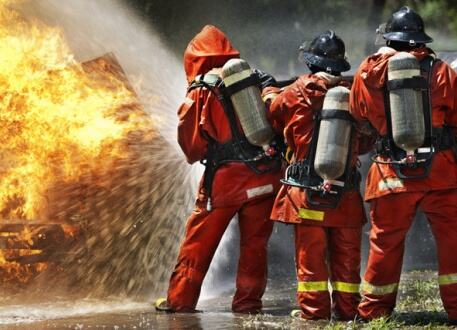
Firefighting Personal Protective Equipment (PPE).
Firefighting workwear, often referred to as turnout gear or bunker gear, is specialized protective clothing worn by firefighters to safeguard them from the hazards they encounter while responding to fires and emergencies. Firefighting workwear is designed to provide protection against extreme heat, flames, smoke, chemicals, and other dangers commonly faced in firefighting situations.
Here are the key components of firefighting workwear:
Protective Coat: The outermost layer of firefighting workwear is a fire-resistant coat or jacket. It is typically made from multiple layers of heat-resistant materials and is designed to protect the upper body, including the torso and arms, from flames, heat, and radiant heat. The coat may have reflective trim for visibility.
Protective Pants: Firefighting pants, often referred to as turnout pants or bunker pants, are worn over regular clothing. They provide protection to the legs and lower body from burns, radiant heat, and abrasions. Like the coat, they are made from heat-resistant materials.
Helmet: Firefighters wear helmets to protect their heads from falling debris and impact injuries. Fire helmets often have a face shield or visor to shield the face from heat and smoke. Modern helmets also include a built-in communication system.
Facepiece and Breathing Apparatus: Firefighters use self-contained breathing apparatus (SCBA) that includes a facepiece to provide a clean air supply for breathing in hazardous environments. The facepiece is designed to maintain a seal to prevent smoke and toxic gases from entering.
Gloves: Heat-resistant gloves are worn to protect the hands from burns, abrasions, and sharp objects. These gloves are made from fire-resistant materials and offer dexterity for handling tools and equipment.
Boots: Firefighting boots are designed to be heat-resistant and waterproof. They protect the feet and lower legs from burns, hot surfaces, and water. They often have a steel toe for additional protection.
Hoods: Fire-resistant hoods, or balaclavas, are worn to protect the head, neck, and face from extreme heat and flames. They are an essential part of the firefighter's personal protective equipment.
Thermal Liners: Beneath the outer layers, firefighting workwear may include thermal liners to provide insulation against extreme heat and cold. These liners help regulate body temperature and prevent burns.
Radio Harness: A harness on the coat or pants allows firefighters to secure their radio equipment for easy access during emergencies.
Flashlight: Firefighters often carry a heavy-duty flashlight for visibility in dark and smoke-filled environments.
Reflective Trim: Many parts of firefighting workwear have reflective trim to improve visibility in low-light conditions.
Firefighting workwear is subject to rigorous safety standards and regulations to ensure its effectiveness in protecting firefighters. The design and materials used in turnout gear are continually improved to enhance firefighter safety and comfort during high-stress and dangerous situations.